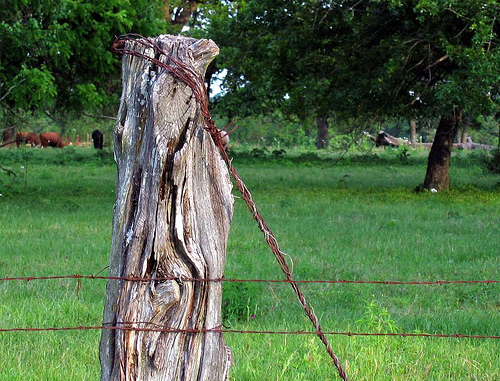
Barbed wire fence, Texas farm scene
(*photo
credit)
July 1, 2007
Being
Resolute
Once the hand is laid on
the plough, no one who looks back is
fit for the kingdom of God. (Luke 9:62)
This passage in Luke's Gospel describes how Jesus resolves to
proceed to Jerusalem and to undergo the trials that are ahead. One
example he uses to show this determination is that of a plowman.
I never worked the plow with horses, but I recall when young in
pre-tractor days that my dad did that hardest of work, namely,
ground-breaking with a team of three horses, yes three. He had to
hold the plow firmly in the ground and at the same time direct the
team. Few occupations demand more energy and concentration than
plowing, and Jesus is well aware of that in saying that ploughmen
never look back. In my school days, George who was ahead by five
years, dropped out and decided to follow his own dad in farming.
He got a job plowing a field that bordered our route to school.
One morning we saw George making a single circular furrow in a ten-
acre field with horses, and we cheered him on. In the afternoon we
looked about and no George, only the single furrow around the
field. George looked back and left farming, at least plowing.
Resolution is needed for success, and this applies also to
our journey of faith, in our following of Christ to Jerusalem and
beyond. The compelling examples Jesus uses are meant for the
disciples who naturally understand that there is danger and hard
work up ahead. Resolute people overcome the temptation to take the
easy road or to go to places that are less threatening. Very few
of us will have to break ground with horses, but there are some
tasks ahead that really challenge us. These require an enormous
amount of concentration and effort to keep in the right direction.
And Jesus' Jerusalem journey is our template.
These Daily Reflections contain numerous examples of planning
and designing, from preparing for the upcoming year or half year to
designing a retreat cabin. Planning is not being resolute in
itself, but it furnishes the groundwork for resolute action. We
could mistakenly think that being "resolute" is determining the new
course of action, but planning is not so; it is merely a beginning
albeit a necessary step. Being resolute involves actualizing the
initial determination and carrying it out without faltering. We
size up what it takes for the journey and decide we will endure the
inevitable road blocks without losing heart. And so we launch out.
Baptism is the launching of our journey of faith. For adults,
this follows a period of maturation and learning about the faith
and what that journey entails. Answering the Lord's call does not
end with the sacrament of Baptism/Confirmation; rather the road
ahead stretches out in what looks like at first an endless
wilderness -- and it will be rough. But being resolute includes
utilizing the fortifying sacraments, the energy to make the trip.
The resolute are those who keep their baptismal vows and do not
turn back. Are we constantly looking ahead or do we look back?
It's a good question as we launch the second half of 2007.
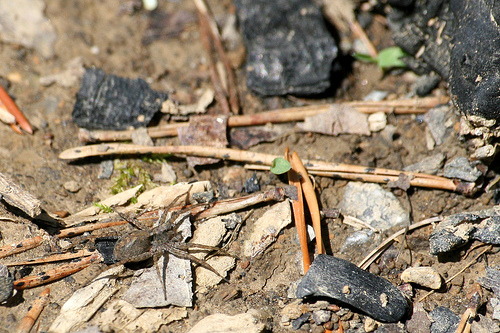
Wolf spider, Lycosa georgicola
(*photo
credit)
July 2, 2007
Jake, The
Wolf Spider
I don't attempt to write specific children's reflections, but
I would like you to pass along to kids my memories of Jake who
inhabited our cordwood log headquarters in the 1990s. Beauty is in
the eye of the beholder, and one might admit that Jake was somewhat
drab and ugly except for some pronounced white and black markings.
But he became special to us for he was able to keep the insect
population under control. I am no authority on spider types and he
was most likely of the family Lycosidae and what is called
the
"Carolina wolf spider."
Certainly, Jake was a true Appalachian, a daytime companion
and not just a night creature. Jake was friendly enough not to
challenge you and just temperamental enough to prefer to be left
alone. Jake was our guardian; he made sure the place was free of
a goodly number of insects that would prove bothersome. The trick
was that we had to like Jake and allow him to roam about at will.
We couldn't sit on him or nudge him about or crowd him in, or else
he just might be provoked to bite the tormentor. But it took some
experience to allow space for Jake in his roaming room. One day we
had a visitor from Germany and I suddenly saw this grown man
quivering at the door and pointing to our hairy inhabitant with a
trembling hand. I said in greeting him, "Don't worry it is just
Jake. You undoubtedly know his cousins, for they inhabit the
entire globe except the frigid polar areas." This did not appease
the frightened visitor who kept his distance, and Jake did his
favorite waltz and gladly backed into a crack in the wall.
The common knowledge is that "wolf" spider did not come from some
resemblance in looks, for that is beyond imagination, nor from the
trepidations engendered among those "fearful" of wildlife, that
portion of humanity with many youthful frights and imaginings.
Rather the name is attributed to the manner in which the spider
runs down its prey, for it does not do so with any type of web
netting as done by so many other spiders. And that is a real story
worth telling.
Many homemakers mistakenly believe some of the scary
literature on tarantulas and they mistakenly think spiders of the
size of Jake are more dangerous than the little guys, but they are
not. Had Jake been provoked enough to bite it might have proved
painful for a spell. Cooperative extension agency literature tells
people to control their spiders on a one-to-one basis, and they do
not recommend general sprays. "Tolerate what you can; spray what
you can't." I would rather say, "Tolerate the insect friends and
begin to fear the spray." Once, where I was staying, the annual
pesticide agent knocked with his mask, uniform and spray can. I
told him to come in a month after I had departed, for I was a
chemist by training with a healthy fear of chemicals, not insects.
I said I'd like a bottle of crickets, real competitors of the Jakes
and not as fearsome to visitors. He thought I was crazy, because
of the way I consider chemical pesticides. A final word on
handling the Jakes of the world. Let them be. They are more a
benefit than a pest. Give more attention to curbing pesticides.

Dog days, pup cools off with a drink from a water fountain in the
park
(*photo
credit)
July 3, 2007
Declare
Independence from Stuff
This is
Independence from Stuff Week (7/2/05) and thus we
should look at our current stuffy situation and review our present
day practices as discussed in Use Less Stuff Day (11/4/05).
But
beyond our living space, which is quite likely getting all the more
stuffed, we need to do more, namely rid ourselves of excess. While
trying to loose our bondage to stuff, we celebrate freedom and the
breaking of bonds tomorrow on the Fourth -- when we will most
likely get stuffed with food. Today's message is a little
different: how do we unload ourselves from the burdens of "stuff"
that overwhelm our office and home place? Don't expect a dozen
suggestions on how to unstuff, for that is burdensome on the brain
in summertime. Are we free to let go and rid ourselves of one or
more items each day? That's not dramatic and revolutionary
behavior; rather it is a habit that, once begun, will reduce the
stuffy loads that surround us and help us to exercise our freedom
to be mobile. July Fourth is a good day to start. And it takes
courage and resolve even while stuff keeps cascading in upon us.
Fooled by numbers. When suffering from the overload of our
consumer culture, we find the first weakness in our lack of perfect
accounting. We most likely get more than one thing new each day
through mail, gifts, drop offs at the door, or purchases that were
made in a rather impulsive manner at stores and flea markets. We
go out to buy a single item and come back with an armload of
impulse-induced purchases. A more proper modification of the "rid"
rule is the equity rule: free ourselves from as many new items as
we take in each day. Now that allows for no additional
accumulation over and above what we already have.
Fooled by time. The first or second or even third day of a
resolution involves the gritty determination to do by routine what
we say we are going to do. Allocation of time is the problem.
Remember, these are dog days, and dogs are not spending time
cleaning up; they just want to keep cool and nap. We have within
us the freedom to say "yes" or "no," but saying is easier than
doing, especially in hot weather. It takes that extra effort to
get rid of something by recycling (I regard it as ridding when I
put the item into my recycling bin, which will be emptied soon).
Fooled by size. I may get a book and rid myself of a sheet of
paper that is outdated. Is that truly one for one ridding of
stuff? Hardly. The quantity of stuff could mount while the
numerical listing of items stays the same. Let's count honestly.
It is part of the needed honesty to say whether this or that item
is really needed for our lives.
Fooled by method. We can't dump it out the window, or in the
roadside junk pile. Nor should we unload stuff on someone too weak
to make a similar resolution. The materials should either be
reused or recycled in a proper place. The refined resolution is:
Rid ourselves of comparable amounts of stuff in a proper way --
and do still more unstuffing when the opportunity arises.
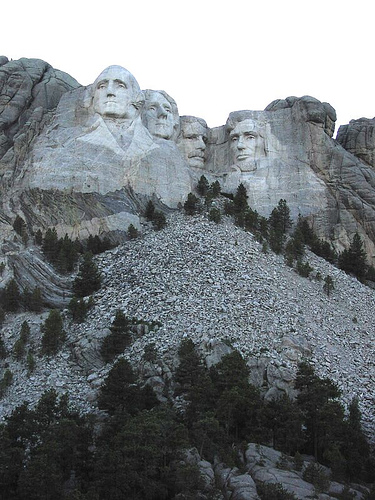
Mount Rushmore
(*photo
credit)
July 4, 2007
Forbearers
and Freedom
We have a way of maximizing the influence of certain
individual "founding fathers" of our American Independence, and of
forgetting or ignoring the rest of the founders. But there is
something the early Revolutionary War generations knew better than
we do: they realized the contribution of the multitudes to the
total effort. We should know better too, since we see the flags on
Revolutionary War graves on Memorial Day. We prefer to recall
Washington and Jefferson as on Mount Rushmore (and they deserve it)
and know the place names of other notable "founders" such as
Franklin, Adams, Madison and Monroe. But what about the long lists
of simple folks who gave their lives for the cause or endured
Valley Forge or Jockey Hollow? Shouldn't we recall them on this
231st anniversary of the Declaration of Independence?
This brings us to the subject of history and historical
record. The leaders always get their publicity but the rank and
file who may have been quite influential fade with the passage of
time. Wives of founders, such as Martha Washington and Abigail
Adams, are notable, but what about parents, siblings, teachers and
neighbors to the "founding fathers," much less their associates and
subordinates who have important places in founding our country?
Where would America be without these folks working behind the front
stage of history? Yes, some reference is made occasionally to
dozens of signatories of the Declaration of Independence,
Revolutionary War soldiers of fortune (e.g., Lafayette or Pulaski)
or leading figures of the allied countries -- France, Spain and
Holland, -- or Englishmen of the 1770s who strived to settle the
dispute through diplomatic means and without war -- even to a
Revolutionary War terrorist (John Painter). But it took an entire
nation or several nations to make a revolution.
Some people became the critical sparks when they tossed tea at
the Boston Tea Party. Others rang the Liberty Bell. We do note
the large signature of John Hancock and the ride of Paul Revere and
those who risked so much at Lexington and Concord and Bunker Hill.
But it took so many more. The thousands of soldier who stayed in
the army through the dark days of that increasingly unpopular war
were very much "founders." Granted, the Sons and Daughters of the
American Revolution do make a valiant effort to preserve their
names and graves.
History involves a community effort and yet we turn it into an
interesting story of a few personalities. Today, on the Fourth of
July when many stand in defense of our liberties we pause to
consider the communal aspects of independence-winning. These folks
who persisted through thick and thin were not the Tory faction;
rather, they suffered through the entire conflict, the outcome of
which was uncertain until Yorktown. The founders had prices on
their heads as traitors and outlaws. Property was confiscated;
homes burnt; patriots killed or imprisoned. We can't minimize the
struggle. Independence gained came at a great price to many, not
just to a few leaders or notable personalities. Lest we forget!
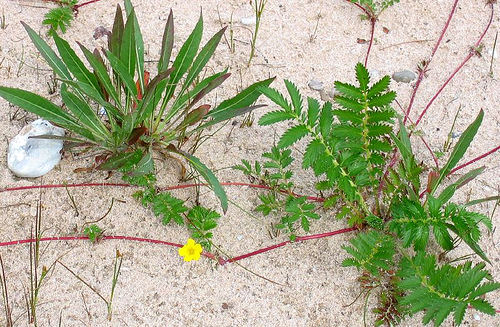
Beach plants, along the shore of Lake Huron
(*photo
credit)
July 5, 2007
Construction
Time in July
For farming folks in this part of America, the month of June
is quite busy with starting and tilling crops and with haying.
Where farmers are not growing wheat and small grains to be
harvested in mid-summer, they have free time while the planted
crops are growing and maturing. Some find handy chores such as
cleaning fence rows; others repair things. Our dad would organize
the next house construction project just when the slack period
from farm pursuits would commence. It certainly wasn't a spur of
the moment decision, for he had planned the house siting and final
design (in his head for he never used written drawings or
blueprints). In fact, he would mentally design the building during
the winter and early springtime and get lumber and other building
materials ahead while prices were lower.
Ideal time. July is always hot and quite often drier than the
months on either side. This dry and hot spell with little or no
farm work pressing was ideal to launch and complete the exterior
work of the new house, which, once enclosed, could await the next
winter slack season to be completed. The winter workers would have
the comfort on being dry and relatively well protected for dry-
walling, plumbing, electric work, border woodwork, additional
insulation, painting and the million of finishing touches.
Exterior tasks. Launching a new project had its own
excitement and we were all caught up in something new. During
summer it was all exterior construction work ranging from initial
grading, foundation and chimneys, wood framing, windows and
exterior doors, roofing, siding, guttering and exterior painting.
These tasks proved to be satisfying work because it was different
from watching slowly growing crops; we could see the actual
progress with each passing day. Since it was a policy to maximize
our skills within our own family and regular workers, we did most
of the building operations. This combination of farming and
construction permitted us to set aside money for future college
tuition, while other small-time farmers were building sheds,
fences, and doing home or barn improvements.
Seeing progress. Construction crews with a given work
assignment are able to see the progress of their own efforts. That
generates an optimism and confidence that the work done is in
public view for all to admire or judge critically. During summer,
the crops are growing and are no more watched than a kettle of
heating water; you let them alone so they mature on their own.
With growing plants one sees little change from day-to-day. But in
construction big differences appear and these inspire and encourage
the workers immensely.
By early August it was time for silo filling, another crop of
hay, then the tobacco preparation and cutting, and back to school.
The house awaited completion in winter and we were satisfied with
the summer. We had deep tans, valuable building experience and an
air of optimism as we moved forward.

Purple milkweed, Asclepias purpurascens
(*photo
credit)
July 6, 2007
Understanding: Welcoming Opportunities for Insight
During this Pentecost season
we continue our reflections on
the second of the gifts of the Holy Spirit: Understanding.
The
traditional explanation is that this gift helps us grasp the truths
of religion as far as is necessary. Involved in this definition
are concepts of "grasping," "truths," and "necessity." Grasping
may be thought of as reaching into a container of truths and firmly
seizing the ones that we most need for personal salvation. The
action may appear to be overly eager or competitive, or it may mean
reaching for a spiritual insight that we may or may not seize with
a certain tentativeness. Truths can be somewhat elusive and so we
sense a need to reach out further and further with all our energy,
as learners grasping for something more -- not as beggars hoping
for a handout. And confidence is all about.
Just as grasping involves the effort of searching, so the
truths are not seen as finite as though they are nuggets of gold.
In fact, the deeper religious truths are infinite in scope, and
thus can never be fully grasped by the human being. Some truth is
more precise than truths. We can begin to understand, but the
quest for enlightenment is a lifelong quest. We do not set limits
on the truth we do not yet understand; rather we affirm that the
quest itself must be understood as a learning process that is quite
meaningful, for it manifests the way we are created in God's image.
And Jesus increased in wisdom, in stature, and in favor with God
and human beings. (Luke 2:52)
The necessary truths involve the manner of conducting
ourselves on our mortal journey. Our manner of conduct includes a
sensitivity to the fellow travelers on our journey, for we are not
on an isolated individual trip but in company with others of God's
children. And a social understanding emerges as we mature, for we
grow together with others. Just as wisdom opens up possibilities
amid limitations and negates any false ideal of total self-
sufficiency, so understanding challenges the concept of "I can
learn it myself." In fact, the true challenge is that we have more
to learn, if we only have the gift of time and the willingness to
join others in the enterprise. We are part of a team that needs us
to help contribute to the total Body of Christ. But our weaknesses
are part of the limitations of all fellow travelers, each with
limited perspectives on their own understanding. The challenge is
to assist each other in coming to a common and socially appreciated
understanding of our cooperative endeavors.
Practical application. A practical person must understand the
real opportunities for progress and then apply his or her limited
talents to the tasks ahead. This understanding is willing to start
with what is lacking (as known in wisdom) and to reach out and
search for those who can help us fill these limitations. We do not
reach ultimate limits on our understanding, but rather we can chart
our growth as an evolving community process. We need to understand
precisely where unique contributions fit and how we enable others
in practical ways to understand their roles as well.

Eastern Gray Treefrog, Hyla versicolor
July 7, 2007 Dying
in Vain
We hear of a death that could
have been so easily avoided and
wonder if this death was "in vain" (worthless, empty, or
fruitless). We hear of another death of a serviceperson in the
Iraq war and similar thoughts arise. Actually the subject matter
may be somewhat a more complex than appears at first. Let's
consider this issue of dying in vain from the viewpoint of
individuals and in August on the ninety-third anniversary of the
beginning of the Great War (World War I) treat the horrifying
slaughter of that conflict.
Does someone die in vain? We may say from the standpoint of
God's entire plan for our existence that all has some worth -- our
life and our physical death. Christians and others hold that the
physical death is actually a transition or change, not a definitive
end of life. Thus with eternal life in mind we affirm that every
life has incalculable value, even the life of little ones who had
over a short period of mortal life on Earth.
I read about the impact of an American statesman while young
when confronted with a drunk; that unfortunate soul drowned by
falling straight down into a one-inch puddle and was too
unconscious to move his head. Vain death? Well in some way as in
all accidental deaths, if only circumstances had been a little
different. But they weren't. The individual did not cause his or
her immediate death and so we don't judge about the "in vain"
factor. Even in suicides that are so often the result of a sick
and troubled mind, we doubt the full culpability of the action and
refuse to judge. If someone is eternally lost, then perhaps his or
her life does appear in vain -- but who are we to judge?
What is becoming clear is that we can say little or nothing
about such individual cases, though maybe more about those who
marched to almost certain death. What we can say is that some
lives can be less empty and worth more, if the individual uses the
gifts given in a more productive manner. One with many gifts who
wastes a life away by substance abuse or just plain laziness is
missing the mark (sinning) by not using God-given talents wisely.
None of us is perfect, and so we all miss the mark more than we
like to admit, but from a present viewpoint some seem to miss it by
a longer shot. Their lives are not in vain, for existence and the
chance to do better is its own worth.
What about chronic sufferers of a paralyzing and continually
more debilitating illness? When we convince them that they can
offer their suffering up, with the Lord, and thus acquire a power
in their life of prayer, their suffering has value; and their life,
far from being of a lower quality, is supremely effective. They
are invited to offer freely and joyfully their sufferings for
others. And far from being in vain, this make their sacrifice
important. Thus instead of missing the mark, such sufferers accept
the opportunity to proclaim Good News and fullness of life while
undergoing the vicissitudes of ordinary life.
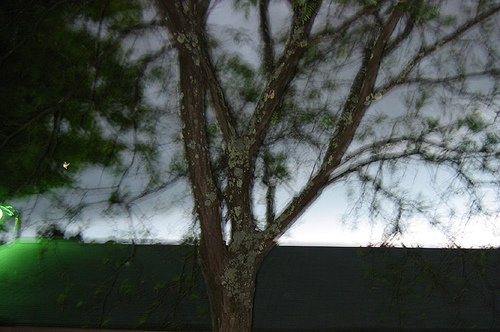
A stormy night, trees swaying in the wind
(*photo
credit)
July 8, 2007
Apostolic
Mobility
The
harvest is rich, but the laborers are few.... (Luke 10:2)
It is amazing that Jesus speaks several times about the
shortage of workers in the vineyard, and what was said two
millennia ago is still so a propos today. The numbers needed are
many; the willing and able ones are sparse. And so we come to what
Jesus is espousing: travel light, stay only as long as needed in
a special place, and adapt to the people and their culture (eat
what is set before you). When unwelcome, move on to another place.
A case of poverty. Today we experience poverty of personnel,
of having right people for the right places. Certainly God will
provide, but we have to do our part with the resources (including
people) at hand. The Church leaders cannot work magic; they are
limited by what is on hand and often that is far from enough to
give service to all the people to the degree both needed and
wanted. However, demands can be made on existing personnel that
are unreasonable given limited human resources -- and these limits
as to energy and strength are part of the poverty that we must
contend with here and now. We join the poor when so limited.
Under- and over-staffed. Few would regard many places as
over-staffed, but when we think of nations like Haiti where a
majority of their medical personnel work in distant wealthy lands
we become concerned. That is not just one nation's problem, but
extends throughout the impoverished world. Over- and under-
staffing in medical and Church circles would be greatly reduced by
equal sharing, but that is easer said than done. However, the
Church could more easily equalize the staffing if it begins to
substitute lay managing personnel for scarce clergy, as is
starting to happen in some places. Church resources are underused
in as many places as they are overused, so ongoing discernment is
necessary as to apostolic mobility -- and this is the lean look.
New vistas. The Lord says not to stay longer than the welcome
deserves. Maybe the push is greater than the pull, for some begin
to realize that they have stayed too long and thus should look
about for a new assignment. The Good News can be spread in
different and even more effective ways than just a few decades ago.
For instance, the Internet is the first century Roman highway
system's template in the twenty-first century. Just like that
marvel of first century engineering mobility, so the Internet can
reach the masses and it can do so far more easily than through
printed and other forms of electronic media requiring more
capitalistic investments.
A final note. Sometimes we get encumbered by our creature
comforts (nice pad, meals, friends, vehicle, etc.) and forget that
Jesus tells us to become detached from many so-called "essentials."
Jesus wants each of us to be mobile in our approach to the things
that aid our efforts. Our trust must be in him and him alone --
and he does demand that we focus on our calling.
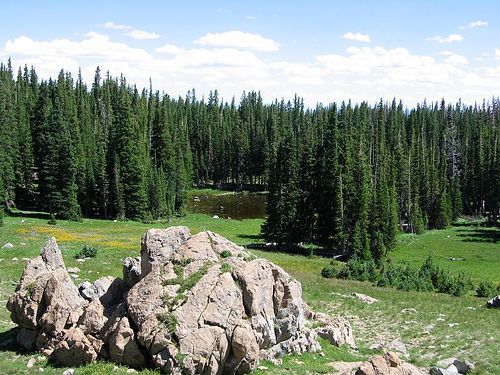
Hidden pond, Medicine Bow National Forest
(*photo
credit)
July 9, 2007
Pauses for
Refreshment
Pleasant memories of hay
harvesting involve Mama's visit with
a pitcher of freshly squeezed lemonade. It always tasted so good
and it was the hit that truly refreshed. Also we took a break in
July housing construction and went to a local service station to
get a carton of cold soft drinks for the crew during an afternoon
work break. These were times to remember and relish because we
always need pauses that refresh -- and especially when thirsty.
And that applies today on National Ice Cream Day.
Annual pauses. If you are reading this on July 9th, you may
find me in the woods on my annual retreat -- the most important
pause I take each year. Yes, we need the longer pauses as well as
the fifteen minute breaks in a work day. We need equivalent pauses
in the work year and at fifteen minutes/day that comes to roughly
a week/work year. This is why an annual week-long retreat is a
good rule for those of us who could be called "workaholics" by
some. However, taking that week off and doing it as a true break -
- and not interspersed with cell phoning and Internet messages --
is healthy and loosens workaholism's total grasp on us. We are not
compelled to work and we truly enjoy the annual pause to relax, to
pray, to not fill our time with extra duties and planned
achievements, but rather to devote our time to the Lord.
Being social. Some of us are caught in achieving certain
amounts in work in planned lengths of time and so we are tempted to
minimize pauses in order to get the work done. But such pauses are
often necessary for social interaction. Should we make an issue of
those who call themselves socially concerned and mean maintaining
a party time atmosphere, maximizing social interrelations with
friendly folks? And are not the socially concerned those who care
for and defend the less fortunate who suffer from lack of social
justice? Is the one who works to save our wounded Earth less
"social" than those who do not give a hoot about the disadvantaged
and still exhibit all the social graces of the well connected?
Thus the word "social" has two different meanings and much has to
do with the nature of the pause, a break to reestablish social
harmony in our world.
Allowing time. Doris Kerns Goodwin's recent excellent book,
Team of Rivals: The Political Genius of Abraham Lincoln,
tells much
about the personalities of Lincoln's cabinet members. Some,
including the President, took time in the day to relax in their own
way. Secretary of War Stanton did not -- and he was difficult to
work with. He was always up tight even though he did a good job.
I turn down other things because I am going to take my weekly
afternoon hike, and I need the time to relax during a seventy-two-
or-so-hour week. We can allow time for many things and sometimes
we must be free enough to change schedules. But taking a pause is
being nice to ourselves. It says that we need time to catch our
breath, unwind, and simply change pace. And so often being nice to
ourselves means being nice to others.

Young ducklings with mother, Big Spring (Kitch-iti-kipi), Thompson,
MI
(*photo
credit)
July 10, 2007
Ducks:
Wildlife of the Month
If you are like me, ducks and especially mallards (Anas
platyrhynchos) fascinate you now as much as when you were young.
They are known to migrate from north to south to avoid the cold
weather but have proven to be somewhat opportunistic, thus sticking
around a great portion of the year within our warming climates.
Why go elsewhere where there is a good living here?
Duck attractiveness comes from many characteristics: they
have a sense of ease and contentment; they have grace in gliding
along on the surface of the water, dabbling under water to feed,
and flying in flocks (though not so much when waddling about on
land); they lend themselves to domestication and have a pleading
look that entices us to give a handout; they are picturesque
especially the male "drake" with his characteristic dark green head
and purple breast, in contrast to the smaller brown and white
female; and they have numerous ducklings who are incredibly cute
and so interesting to watch. Mallards are quite numerous and
widespread and are perhaps the most recognized waterfowl in the
world. Because of sheer number, millions are hunted each year.
We see ducks today on farm ponds, rivers and virtually any
place with water even though they are generally a wetland species
feeding on aquatic invertebrates. The mallards are on all
continents though they dominate the Northern Hemisphere. They molt
in late spring; they have a wide appetite as omnivores: seeds and
cereals such as wild rice, hackberry, mollusks, insects of many
types, worms, gastropods and arthropods, small fish and fish eggs,
frogs, and snails. Ducks like to glean the grain fields that keep
them around longer during the year.
The quacking of the female is quite familiar to us all for it
is audible for miles. The males stay with the females through
autumn and winter and leave soon after mating. The female lays up
to a dozen eggs and then incubates them for about four weeks. The
ducklings are led to water and there is no return to the nest.
During these hot July days we can find ducks sleeping on the stream
and lake banks. Their life is one of water and while most have only
a one- or two-year life span some are known to live up to sixteen
years of age.
To be complete, duck is prized as a food delicacy in many
cultures, especially in the Oriental ones. Duck is a gourmet dish
though I insert this in passing due to my on-again, off-again
vegetarianism. But beyond being prized, ducks in the modern age
suffer from human dangers such as pesticides and other chemicals
and oil spills as well. While duck hunting is popular, we need not
dignify this as true hunting, since the duck is so visible and is
easy prey to human hunter and other beasts alike. All in all, this
is a better quality world and the gentle and entertaining mallard
gives it a special sound and a rich color that is hardly equalled
by other fauna on this planet. Let's let them live and let's
appreciate them for what they are.
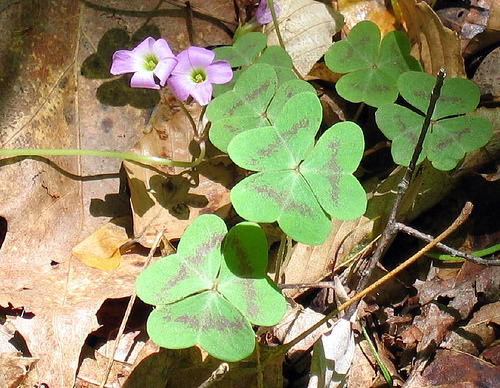
Violet wood sorrel, Oxalis violacea.
(*photo
credit)
July 11,
2007 Cheer Up the Lonely Day
Not too many people know this
designated day or else they
might be embarrassed if we call or email them on Cheer up the
Lonely Day. Don't let the risk of their knowing about it stop
us.
Just get a chuckle realizing they know too much. If they wonder
why you called, just say something triggered you to think about
them and you want to spread a little cheer.
Contents -- Be upbeat, but that may be a challenge. Not all
of us have a sense of humor. One might say: "I have heard so much
bad in the daily news accounts that I find it hard to be optimistic
and I never tell jokes well." They don't have to be new and
different tales to make the person laugh. It might be an
interesting account of something that could be shared with this
person a second time. Thus keep a note pad nearby and jot down the
name of the person who will be the special recipient of the select
piece of information. We were thinking about them -- and maybe we
can say that we are offering this day as a special day for them.
Passing state -- Acute loneliness is not necessarily a
permanent state. Some have just lost loved ones or their own
nestling (child) has departed, or a friend has moved away. They
need this refilling of the gas tank of social relationships.
Others may be going through a specially hard period due to finances
or illnesses, and your thoughtfulness comes in handy. Remind them
that the times are moving on and the condition will change maybe
even with the weather. Cooler weather will come. Be short.
Everyone can be lonely -- This point is often overlooked
until
one sees people compulsively talking on cell phones while they wait
in line or, heaven forbid, while they drive. A deep and abiding
sense of loneliness is a universal condition for our hearts are
restless until they rest in God, as St. Augustine reminds us. Some
are more uncomfortable with this state of restlessness than others
and they hope mere socializing will cure it -- as though it should
not be there. Other forms of loneliness such as depression beset
people in different degrees and can be an illness. We often suffer
from some degree of depression when changing occupations or
discovering a new illness in ourselves or a loved one. Even at
such periods, we can remind ourselves that we really are not alone.
The Lord is with us on our journey of living and dying.
Sharing the lonely condition. Sometimes even the melancholy
ones can spread cheer. It was known that Abraham Lincoln (who was
disposed to sadness) prided himself on telling stories, and some of
these were the humor of that period and he would laugh louder than
the hearers. On his circuit riding as a lawyer in Illinois,
Lincoln would spend much of the night at a tavern (though he never
imbibed), telling one story after another. His associates reported
that he enjoyed his own stories more than the listeners did.
Ultimately all of us have a streak of loneliness (the restlessness
of a traveler on the journey of life) and so all benefit on this
day, even the one who gives the cheer.
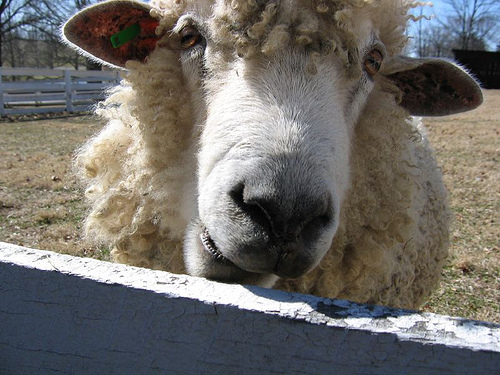
"Bessie", close up of a sheep looking through fencee
(*photo
credit)
July 12, 2007 Where Have All the Honey Bees Gone?
Honey bees are declining in population in North America as
well as in Europe (up to an estimated 80% decline). Some regard
this fact with alarm as occurs when any species declines. Perhaps
the alarm is greater in Europe where these were natives. The
regular honey bee was brought to North America with early colonists
in order to provide honey, and these busy little creatures have
been doing a good job for centuries on our shores. Prophets of
doom are calling this "colony collapse disorder" (CCD) because
entire colonies seem to be wiped out or nearly so. Before the
alarm becomes overly disturbing we must recall that there are many
other pollinators besides the honey bee. The bumble bee is many
times more effective in pollinating, and entire orchards can
flourish from the effects of native pollinators. However,
California almond growers and others speak about trucking in honey
bees to pollinate their operations and show worry about this CCD-
caused shortage.
Environmental threats and disasters are handled in three
stages: discovering the problem; determining the causes of the
problem; and the discussing and implementing solutions to the
problem. However, here a problem (decline of honey bees) has been
unearthed but the causes are not yet comprehended. Some organic
honey making communities say they do not have CCD problems though
other organic growers are reported to have them. Of course, this
would not rule out as causes some chemical pollution because today
some chemicals have been spread so far and wide that they are
essentially ubiquitous. Maybe it is a cumulative stress factor
that includes moving the bee hives from place to place, plus
certain opportunistic biological agents, plus small amounts of
chemicals. Some regard the problem as cell towers or other forms
of radiation that confuse the bees. It may be something to do with
the flowers and not the chemicals in the air or in hive management.
Entomologist May Berenbaum of the University of Illinois offers her
own theory in the June, 2007, issue of Smithsonian. She thinks
honey bees know something we don't know and they are getting out.
She thinks aliens from another planet have abducted the smartest of
this world's organisms and they've picked the honeybees. And we
are sure there are others with reasons that need considering.
We cannot move towards a solution to the CCD problem before
the causes are determined. My brother Charlie, the apple grower,
wants me to tell readers that apple syrup is as good if not a
better sweetener than honey from the same blossoms and it does not
take honey bees to produce it. He is satisfied with the native
pollinators on the grounds of his orchard, which uses virtually no
chemicals. We find in so many areas of our natural world that
tinkering with wildlife results in unexplained threats and
extinction. But on second thought the honey bee is an exotic that
was introduced into the North American continent by Europeans. In
a little while someone will find the cause of the disappearance and
in the meantime let us regard CCD as worrisome but not
catastrophic.
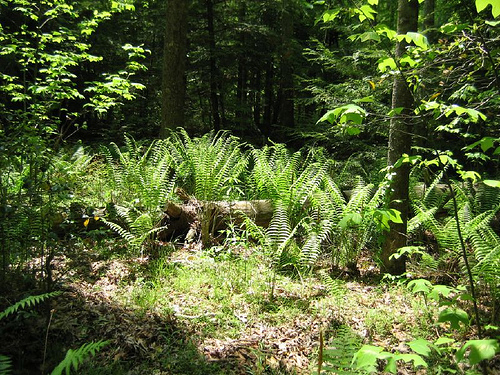
Osmunda cinnamomea, cinnamon fern
(*photo
credit)
July 13, 2007 Tolerance and the Smoker
Should we tolerate smokers and what does this mean? We may
not tolerate the practice in certain places but where does
individual practice enter into the field of tolerance. A
smoker should be cautioned if he or she is hurting his or her
health by excessive smoking. But what should we do about it? If
this is a youth and the enticements come through company
promotional materials directed at the budding smoker, then
tolerance for the health of the youthful individual calls for
action to be taken against the companies. And such is the current
thinking of our national policy. An adult individual who is not
hurting another should be allowed to make his or her choices even
when it shortens life while giving a certain enjoyment and relief
of stress. But even here there are moral issues and limits on our
tolerance.
ETS in public places. In the last two decades people have
become conscious that one does not have to tolerate smokers in the
presence of others who are thus affected by environmental tobacco
smoke (ETS). Current customs hold that smokers should not
contaminate a restaurant or public place, for this infringes on the
rights of non-smokers in the public place. Well and good, for
tolerance is protecting non-smokers from possible assault by a
smoker who is hurting himself or herself and all who must breathe
the second hand smoke -- and that is now known to affect human
health.
ETS in private places. Now we move beyond the public place to
the privacy of the home. If someone is suffering from emphysema,
it would seem proper to have a court order to enjoin smokers from
practicing, whether they be visitors or even immediate family
members. Would some still smoke in the presence of a respiratory
victim? I know of at least one such case and the victim eventually
died; all the while the two smoking resident relatives continued
smoking and justifying themselves in thinking that tobacco was good
for them. What about smoking in the presence of non-sufferers, who
could potentially be harmed by the practice? Here the court does
not and should not step in, but every effort of moral persuasion
should be used to say the living space is contaminated. As for
privately owned work space, legislation is in place through the
federal Occupational Safety and Health Administration (OSHA) and
through state agencies to grant non-smoker co-workers rights to
fresh air.
ETS and the womb. Health experts say that pregnant smokers
place the fetus in the womb at risk. What should be done about it?
Certainly we do not imprison an expectant smoking mothers to keep
her from smoking. We use all the powers of our own persuasion to
have her halt the practice (we could even be harder on the co-
occupants of the household), but keep the long arm of the law at a
distance unless the life of a party (mother or fetus) is at risk.
Tolerance seems to reach its limits, for here freedom of smoker and
moral persuasion of non-smokers clash. What do you think?
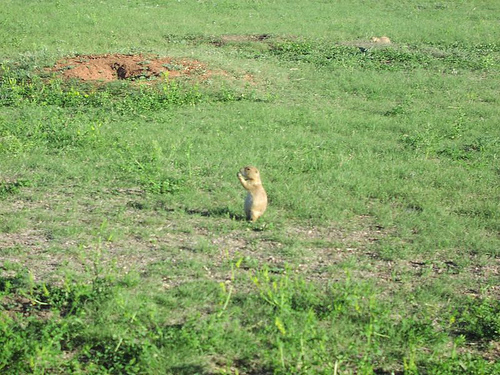
Prairie dog, North Dakota
(*photo
credit)
July 14, 2007 Animal
Protection and Welfare Groups
July "dog days" are a perfect time to mention the various
groups who protect and offer welfare to animals in various ways.
People who want to get involved with animal protection can choose
from broad categories of support and then look into where their
resources can best be applied given limitations of age and
location. In the past I have refrained from dealing with this
animal protection issue mainly because some larger international
animal groups have been highly funded while local welfare
organizations have often struggled to survive. How do we show our
support and still not get cynical when we are aware that more
attention was given to adulterated pet food than to the lack of
food for millions of Africans today? Caring for some part of
creation does not mean we overlook others; in fact through caring
for some, the good of the total community is easily understood.
These groups range from the academic and research
organizations to radical activists who seek to free animals used
for testing from laboratory pens. For instance, the World
Wildlife Fund (WWF) focuses on the deepening crisis of certain
species who are being denied traditional habitat or nesting areas
and says that these species have become threatened and endangered.
The WWF raises alerts about various species and supports local and
regional organizations working in standard and novel ways to
protect animal habitat, resting areas, and migration routes. Also
numerous international groups exist for whales, birds and
especially raptors, seals, tigers, and bears. People for the
Ethical Treatment of Animals (PETA) is especially concerned
about
the manner in which chickens are raised to furnish the needs of
fast food establishments such as Kentucky Fried Chicken. They have
recently received publicity in various countries such as Russia for
livestock raising practices.
Animal Liberation Front (ALF) is an international radical
group that believes the best way is to directly target the
laboratories that house animals such as monkeys used for research
on everything from cosmetics to critical medicines for human
health. ALF will actually break in and liberate the animals and
hide them in safer environs, or they will damage or threaten
facilities and their caretakers. Some radical groups have changed
habits in our fashion world in regard to bird feathers in hats at
the turn of the 20th century and more recently furs. A small group
of individual urban spray painters certainly made the wearing of
furs in the fashionable sections of New York unpopular.
Individuals and local organizations are just as dedicated to
giving protection and welfare to animals, and in many ways have
been quite effective with less money and popularity. These groups
often depend on the heroic efforts of local volunteers to rescue
animals for adoption or to offer refuge for those abandoned by
others. For animal lovers on limited budgets, adoption of animals
in temporary shelters may prove to be quite satisfying. Also some
may wish to establish a bird sanctuary on their property.

Stately Mount Robeson, Canada
(*photo
credit)July 15, 2007 Know Our Neighbors
And who is my neighbor? (Luke 10: 29-37)
The lawyer asks Jesus what he must do to inherit eternal life,
and then shows himself to be well versed by quoting Deuteronomy
6:4-7 (loving God above all) and Leviticus 19:18 (loving our
neighbor as ourselves). And he goes on to ask Jesus who is his
neighbor. Jesus tells him about a victim who is waylaid and
neglected by the passing priest and levite and then assisted by a
Samaritan who, while despised by many in the audience, gives
attention, binds up wounds and takes the victim to an inn.
North American neighbors. This month we have a sizeable
number of photographs of scenes from beautiful Canada, our good
neighbor to the north. I am always amazed how many people in our
country cannot name more than one or two Canadian provinces, or
select provinces from a list of names, much less place them on a
map in the proper order. This land giant to the north is a mystery
to many and yet our foreign trade policies affect the Canadians as
much as they do our Mexican neighbors to the south. More attention
has been given to our southern neighbors due to immigration
pressures in recent years, and often we turn attention to Latin
Americans and look only in one direction. But we need to improve
ourselves and look in both directions, for we are all truly one
people on this continent.
Worldwide neighborhood. We have repeatedly stated that the
electronic media have done much to bring the world's people very
close together, truly an emerging neighborhood. There are many
advantages of quick communication and learning about other peoples.
However, in knowing we also see our expanded responsibilities in
dealing with those neighbors who suffer in some way -- and that our
excesses and luxuries can be seen today side by side with the basic
needs of our fellow human beings. The Parable of the Good
Samaritan makes us painfully aware how omission (by the ignoring,
excusing, or denying levite and priest) damages the neighborhood.
This occurs through blatant disregard for hurting neighbors; on the
other hand, active concern does the very opposite (by the attention
from the good Samaritan). Do we allow the troubles of life to make
us pass up someone who is obviously lost or confused or has a
vehicle broken down? Are we willing to be good Samaritans? And
does this disregard at the local level extend to the nation and to
the world as well? If we ignore the malnourished in Africa and are
drawn to attend to only those in a favored part of the world, we
are limiting what constitutes a worldwide neighborhood. The words
of Jesus in St. Matthew's Gospel (Chapter 25) haunt us:
For I was hungry and you never gave me food.
Mid-July is a perfect time to abandon our summer lethargy and
tend to our continued spiritual growth. It is time for that simple
prayer, "Lord teach me to see those in need and to know when I
must go out to them and satisfy their needs."
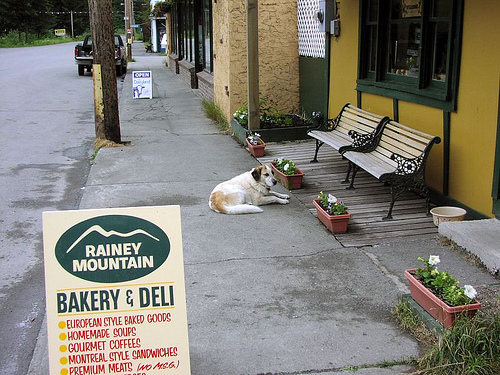
Patience as dog waits on owner, outside small-town cafe
(*photo
credit)July 16, 2007 "Nowhere" in July
The July day is stifling and we experience our brain sizzling
or maybe it is already fried. We can bike or hike or ride no
farther, and yet we do not know the whereabouts much less the
interior of new places. All we know for sure is this is a
motionless "nowhere" on a lazy July day, and even the watch dog
seems unable to move or bark. We enter the store and the floor has
a slight sag or down bow that forces us to increase our gait lest
we stumble. Here we are in the center of attention for a number of
fixtures gazing at us while smoking, and when they exhale we know
they are alive; their facial wrinkles don't allow us to guess ages.
Finally as our eyes adjust to the darkness, we find the counter and
the cabinet to the side with the soft drinks and water bottles --
all sufficiently high priced to make us know for sure this place is
connected with the outside world in 2007.
I feel like pulling my dumb trick in France and never saying
a word to hide the fact I am not from here. But this group knows
the difference. "Just traveling through?" the storekeeper asks in
the name of all the seated smokers who are here to judge. "Un-
huh," I respond, still not telling much, for most Americans would
say that much in a rather uniform style of speaking. Oh what is
the use? Let's exchange a little chatting for that is what life is
all about. So I volunteer that it was good to find this place
before I died of thirst. That brings a knowing response from all
the audience, and thus we lapse into weather pleasantries. And
when the clerk rings up the purchase, I think she even gives a
slight smile and a "Thank you, and come back again."
What I refrain from saying until outside of the door is "This
is sure a lazy looking place," but that is within ear shot of the
old dog who seems to nod as though in affirmation; maybe he (the
dog) is really trying to shake off the gnats from his eyes. In
driving off, I do not recall seeing the name of the hamlet though
it undoubtedly has one, even though the post office and half the
stores are boarded up. Yes, there were quicker days in this place.
And then in a continued cynical mood the comment springs up that
"At least they had refrigerated drinks. Someone got off their
rumps long enough to electrify the place."
As the place fades in the rear view mirror, it strikes me just
how many hamlets have a resemblance to quiet, nearly forsaken
Dumbach in Alsace from which my grandparents came. I hope the
younger folks who are from "Nowhere" are beginning to find a
promising life. And amid all the negativity resulting from a half
fried brain, the second thought slowly emerges. This town still
has life enough to refresh us and to treat us with decency when we
stop by. I hope most of the world still has watering holes left
and hospitality to go with it, for at any one time a surprising
number of us are on the road -- and we expect kinder words and
deeds than the thoughts that enter our fevered brain in July.
Maybe our hostility is part of almost having a heat stroke in July
and not a permanent condition. Relief comes in cool drinks.
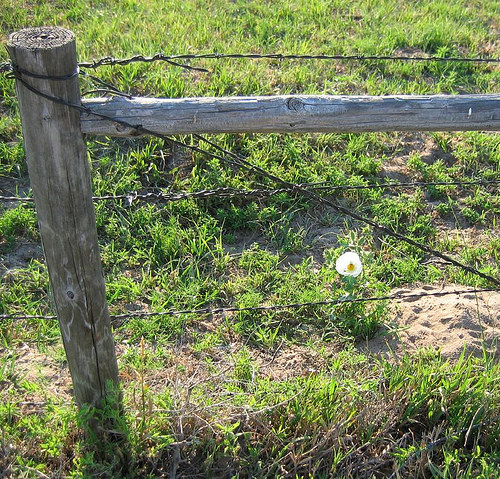
Prickly poppy, Argemone pleicantha
(*photo
credit)July 17, 2007 Agritourism
One of the numerous forms of tourism that has been emphasized
in these writings is ecotourism. However, people overlook one type
of tourism, agritourism, that may not demand as much travel as
those required to go to distant lands. And this tourism into rural
America is enjoyable for the entire family or at least most of
them. Surprisingly many urban Americans, who are now part of the
world's majority of urban dwellers, opt for a change and a dabble
into old-fashioned rural life. Some satisfy this desire to a
limited degree by going out and picking "your own" apples or
raspberries at certain farms that are generally within an hour's
drive of a major city. Success for these places comes through
publicity from road signs or from newspaper stories, or from the
state or local tourist agencies.
Supplementary farm income. Farm families are discovering that
opening their place to visitors who desire to experience farm life
can be economically beneficial. There are profits but it takes
farmers who like people to make this work. These select few can
organize hay rides, show kids how to milk cows, or have them enter
and supposedly assist in garden work without getting on nerves.
They may even go farther and include a combination of bed-and
breakfast facilities plus a store outlet to sell produce from the
farm. Some friends went to Europe and what they talked about most
was an evening on an Irish farm/bed-and-breakfast combination.
Meaningful program. As with any limited skill experiences
there are limits on what urban people can do without long term farm
work. Most people are unaware that farm tasks require acquired
skills and that these are not easily gained, and certainly not
overnight. Providing an authentic experience without embarrassing
the tourist is a challenge -- but some are able to do this well.
A retired, able-bodied and adjusted host farm couple with a sense
of humor can do splendid work. They need to pace themselves well
and be prepared to feed and lodge the visitors -- and enjoy the
social interchange all the while. If the visitor is paying, there
is the burden of keeping them happy, and some within a tourist
group may just be permanently disgruntled. Thus granting reading
and quiet time for the ones who do not like the hot sun or who do
not want to exert themselves makes for a better all around program.
Outside support. Often the people needing a farm experience
are inner city youth, but urban benefactors rather than the farm
family should select them and support their expenses. The farm
family is looking for income, not a chance to do charity. One
should not expect the host to be the principal donor as well as
have the burden of furnishing the entertainment/experience.
Remembering. As with all tourist experiences, visitors should
be encouraged to record the tourist happenings either through
cameras or audio- or video-recording while undergoing the
experience, or by writing up the experience after they get home.

Eumeces laticeps, broadhead skink
(*photo
credit)
July 18, 2007 Eat Simply
Four senators are investigating whether people living on food
stamps (three dollars a day) are weakened by the low amount
allotted. Well that amount is my grocery budget per day and I try
to keep it, except for meal eaten with others (though half of these
are potlucks). Three dollars a day is certainly sufficient if one
eats simply and doesn't buy Starbucks coffee. One change I make is
to convert some of the food money to garden supplies, which allows
about one meal a day during the growing season to be a soup or
salad that comes from the garden's produce. Here are some
additional hints for eating simply and nutritiously and for
stretching a food budget dollar:
* Cook with whole grains (oatmeal, rice, etc.) which are
regarded as extremely nutritious though many people avoid them, and
go very easy on bread and baked goods;
* Prepare dishes starting with dried beans, butter beans,
split peas and lentils and thus save on some canned foods. And
patronize stores with bulk items, wholesale pricing, fewer choices,
and omit the frills of upscale grocery chains. Purchase bulk
everything that keeps, from hot sauce to vinegar, and avoid name
brand products;
* Eat little or no meat, for that is high priced;
* Use few prepared foods and sweets such as frozen dinners,
prepared pasta salads, small unit salad dressings, pies, cookies,
and cakes;
* Select certain foods for snacks: fruits, raw veggies, nuts
and possibly popcorn. Avoid the potato chips and what is known at
junk food, which is quite expensive;
* Buy seasonal foods and pick some wild fruits and berries
when in season to allow a taste of different materials that could
be quite costly outside of season;
* Gather wild greens and poke shoots in spring and grow
organic greens in pots in winter;
* Drink water or your own prepared sweetened drinks instead of
buying soft drinks (a major expenditure from food stamp money --the
soft drink manufacturers insisted that soft brinks be included in
food stamps); and
* Consider homegrown herbal teas in place of coffee.
A single person can live off groceries coming from current
food stamp amounts (three dollars a day). Unfortunately, the above
listing of foods is not what those on food stamps normally eat.
Experienced cooks may eat simply and nutritiously, but those who
eat prepared foods will watch their food stamp budget disappear.

Shoreline at Manistique, MI
(*photo
credit)
July 19, 2007 Mimosa, The
Silk Tree
Most flower lovers will admit that the fragrant and delicate
pink and white blossom of the mimosa or silk tree (Albizia
julibrissin), which blooms in the earlier part of summer is
quite
beautiful. This member of the pea family is found in a naturalized
form in the southeastern United States as well as Louisiana and
California. Mimosas are found in all five of the Central
Appalachian states (Kentucky, Virginia, West Virginia, North
Carolina and Tennessee); the tree was introduced into this country
as early as 1745 but is a native of Asia where there is a natural
range from Iran to Japan. The tree has no value for shade or for
wood, and can be termed a "weed" tree like the "tree of heaven."
Yes, the mimosa as an exotic has a moderate capability to
become an invasive when left uncontrolled. Thus it is regarded as
an ecological threat in some warmer forest areas where its spread
is not curtailed. A house with a mimosa, which is next to a semi-
abandoned woodland lot, is a perfect breeding ground for new
mimosas that can spread and compete with the stressed native
species already battling to compete with a growing list of
invasives. Being a member of the pea family, the mimosa produces
a large group of durable pods that can yield new tree sprouts over
the surrounding territory. And these are hardy in a variety of
soils and over a reasonably wide range of climate conditions. This
is especially true when near a building or a cove that protects the
plant from extreme conditions -- for cold hardiness is a limiting
factor to its spread north or in altitudes above 900 meters. Even
if mimosas die back in a colder winter, they can resprout.
In this country we have had our fill of invasives from kudzu
to mugwart, and so non-natives are always suspect even when their
flowers are quite attractive and they can be controlled to a
certain degree. Mimosas that generally prefer full sunlight are
found on roadsides and in vacant lots, and need to be cleaned up
before the spreading can commence.
The very first step to control them is to halt the sale (found
on the Internet) of mimosa plants, though some people seem unaware
of their ability to spread far and wide in warmer areas. Suitable
substitutes include the redbud, serviceberry and flowering dogwood.
Next, one may be inclined to cut down the tree and this can be done
when it is blooming and before the pods that can scatter to
surrounding areas form. Girdling of larger trees can prove
effective for that tree but it does not kill the stump that can
return again next year. Small scattered sprouts can be pulled up
by hand, especially after a rain. Mechanical methods are preferred
over chemical means of control because the recommended chemicals
can affect other plants as well.
We hope this reflection does not spoil your appreciation of
the mimosa blossom. I also find them delicate and delightful where
they grow, but I have come to dislike them after knowing a little
more about the history of this exotic species.
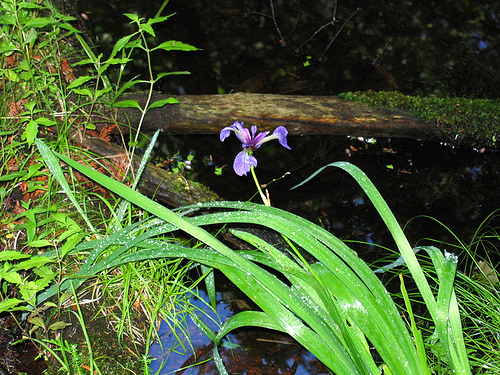
Iris versicolor, wild blue iris
(*photo
credit)
July 20, 2007 Moon Day and Moonshine
You mean you have done over 1,400 reflections and never one on
the moonshine or "white lightning" drink of your Appalachian
region? You are right but now I will make up for lost time, Today
is Moon Day and I must address this question for better or worse.
My response is that the moon (See June 30th reflection) is a
wonderful beauty in the sky but it never triggers for me any
thought about that allusive drink. You see, making moonshine as
was popular both here and as "bathtub gin" in urban America during
Prohibition and the 1920s is a rare practice today. It is only
slightly less rare than chicken's teeth. At the National Cathedral
dedication in 1990, Philip, the Duke of Edinburgh and husband of
Queen Elizabeth, asked me whether they still had "stills in
Appalachia." Unfortunately I could not understand the question and
had him repeat it because of my difficulty with languages -- and
pure English is one of them. In essence I told him they were not
near as much in style in our region as they once were. When asked
by National Public Radio for examples of moonshiners I was equally
hard pressed -- though rare specimens appear every so often. The
truth is that marijuana is far more lucrative to that type of
person than are stills in our region.
At various stages of my long life, including a period in my
Jesuit studies, I did indulge in creating and operating a small
still, but nothing much resulted. The cooling coils leaked and the
good stuff went as steam into the atmosphere. I would not pass as
an experienced moonshiner. Unfortunately a great number of others
who indulged through the twentieth century did not do good work
either, and their defective "moonshine" poisoned the purchasers of
their product. When we were young, our home town had survivors of
such imbibing who suffered from what we termed "jake leg." The
entire sordid history of moonshining is fraught with difficulties
for the perpetrators, customers and even the revenue people who
braved the bullets to find and ax the stills. Very little remains
of that culture, even though one can still get a taste of the
product of their work if you know the right people and places.
Let us look in a more redeeming way at "moonshine," for it is
beautiful as a terrestrial phenomenon rather than a moonlit
occupation. The soft glow of the nightly moon around full, "Buck
Moon," at the end of this month is always a wonderful time to spend
an hour or so outdoors in high summer. It is even better in some
ways than taking time for the moon in high winter exactly a half
year away. The moon's delight is worth celebrating far more than
the imperfect products of people is scratching a living by stoking
the fires of a still's distilling pot (sorry about the mixed
metaphor). However, scratching came in growing the corn for making
the mash that had to be fermented. No, let us leave such history
behind and concentrate on the soft moonlight, which delights the
soul, and not on unlawful practices. But I have a soft spot for
all who worked by moonlight, for they were energetic enough to want
to keep a growing family alive. If it takes a moon to get folks moving,
then let's encourage them to spend a night in summer's
moonlight.
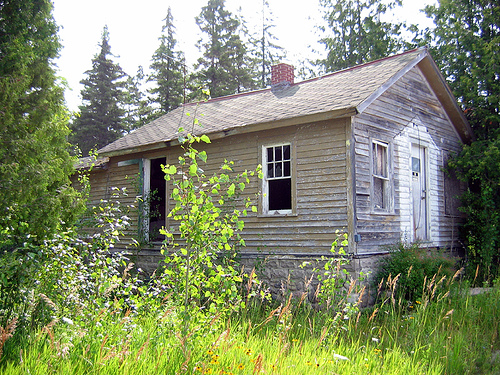
A long-abandoned homeplace
(*photo
credit)
July 21, 2007 The Abandoned Homestead
On our home farm (not the above photo) we had the traces of an
old log cabin. You could plot out the access road and a few
specially placed rocks and other traces detected by a crude
archeology. Some homesteads can hardly be traced; others are more
easily detected as the one photographed here. We are left to
wonder how it was when the place, no matter how poor, was a seat of
love and care, of a warm bed and cheerful fireplace, of meals as
good as could be cooked given the simple fare, and of the sitting
outside in the evening just enjoying the trees, the feel of the
fresh air, the sound of night birds, and the smells of the growing
season. This, though ever so humble, was a home to a family, but
times changed and they had to pull up stakes and move on. Another
place was alluring and a dream had to be fulfilled. So they
stashed their belongings in their covered wagon, hitched up and
pulled out. That home became the relic of the tidal wave moving
further West.
Poor abandoned homes such as these will never merit a historic
marker but they are somehow part of our history. I have often
thought about what such homesteads were like when in full occupancy
and teeming with kids running about. Still a more sobering image
is that of the last one out. I went across the street yesterday
and sat on the porch with Dave Maggard (his song is number one this
month on the national Bluegrass listing), and he said he wanted to
go back to his old homestead. He said he was the last one out. It
seemed to have hurt him a little, and yet such departures are
always bittersweet. There is little documentation (tax bill, an
eviction notice, a letter inviting the folks to come west of the
Mississippi). But the final documentation is the home itself, and
here it sits, witness to better days and happier times.
They tell me that in parts of Europe when the last person who
remembers those in a grave are gone and there are no more flowers
laid down or grown nearby, the grave is considered abandoned and
the bones moved to an ossuary in the church or other collecting
place. Abandoned homes await a similar fate and some are torn down
and others burned. I have advised against some buildings being
dismantled by those who are unskilled, for fear of a possible
accident. As for burning, the local firehouses used to burn such
places for practice but not any more in our area. Again, there are
too many risks involved. An owner of a "abandoned barn" on my
daily hiking route told me that he wanted the sagging structure
down but a doe and some fawns were staying in it through the winter
and he just didn't have the heart to destroy it.
Occasionally one or other of us returns to the abandoned
"home" place. I distinctly remember my father's return to his, and
how deep the hurt was in inspecting its current condition. Such
sites are unsightly and I suppose there is a lesson here but I
simply can't think of it. Maybe the best we can do is say a prayer
for those who have moved on. The old place has seen better times.
Isn't our true home still up ahead?

Robinia hispida, rose acacia, Wolfe Co., Kentucky
(*photo
credit)
July 22, 2007 Martha and Mary Revisited
My challenge is to again tell the Martha and Mary story (see
July 18, 04). However the battle of busy bodies versus the
contemplatives makes me pause once again. Is there more to this
story than past reflections, for in my heart of hearts I thought
Martha chose the better thing to do? Even now, that struggle
continues and it may have a valid point to it, for preparing the
many details of a pleasant meal for the Lord was the better thing
when it comes to doing. Thus Martha (feast day next Sunday) is the
patroness of homemakers, cooks, hospital dieticians, innkeepers,
domestic workers, restaurant owners/managers, waiters and
waitresses -- not bad for doing the lesser part. And later in
Scripture it was Martha who did the right thing and went to greet
Jesus at her brother's death, not Mary who remained in the house.
The key is the difference between doing and being.
Martha was
driven to doing and Mary to being. There are times when we have to
do things and do them well, and undoubtedly Martha knew when to do
them well, or she wouldn't be the patroness of doers. If the Lord
is at table with us, and we enjoy his presence and being near him,
just being would certainly be the better part of a dinner. Now if
the service personnel decide they also want to choose the better
part; they will all put down their trays and come over and around
the table to hear and enter the conversation. In a short while the
customers will become somewhat irritated -- and why not? It is a
question of choice in doing and being.
Be happy in doing. Even one who serves and cannot take the
greater role can still be content with the role that is being
played, and not reprimand one party for being able to be present to
a guest -- and not helping with the serving. So the great
difference is not in the choice of one in competition with another,
but in being happy while doing the serving or the lesser role.
Thus the doing and the being come together in a new form that is
really not the better part, but the best that can be achieved at a
given time.
We are to make Christ present in the world in which we live.
It is a mighty powerful task ahead of us, and so it takes all we
have in talent and gifts. Some of us are in the right place at the
right time though we all can say we do the best with what we have
got. However, our past missing of the mark has left us somewhat
behind in doing and thus we must make up for lost time. Can it be
done? Nothing is impossible with God's grace. Some who were ahead
of us in the gift of using time better have naturally a more choice
place. We should not fault them and certainly not reprimand them
for their better state; rather we should thank God that their
gifts were well used. At the given situation Martha could have
chuckled to herself and said a good word for her timid sister. What
we learn from Martha is that we too should do the serving and
preparing for others, and do so with utter contentment. This is
the best we can offer. And in so doing we can be -- happy. What
more can we ask of the Lord, even if others may relax with him?

Glacer near Hyder, Alaska
(*photo
credit)
July 23, 2007 Is the Glacier an Endangered Species?
Only once did I come near an Alaskan glacier in order to
admire the pale blue ice that captivate first-time viewers. Was
what I saw endangered? By 2002 these Alaskan glaciers were
disappearing at a rate of 37 cubic miles a year and were
contributing half of the ocean water from shrinking mountain
glaciers. Nearby inhabitants know things are changing and all due
to climate change, though they don't always realize the strong
contribution of Alaskan melted ice to the ocean rise. As the
glaciers melt so does the permafrost disappear, and this leads to
new wetland and emissions of locked methane gas that has a positive
feedback of creating even more atmosphere warming. And this
Alaskan phenomenon parallels the break off of the 1,200 square mile
section of the Larsen Ice shelf from Antarctica in 2002.
Tourist trade. Those hearty souls living near alpine glacial
regions or ice sheets in Greenland know that the natural phenomenon
in their back yard attracts tourists. However, it is astounding to
see pictures of the front of a glacier taken seventy-five years ago
and then to see the distance of recession documented by a current
picture. And the rocky rubble that remains in the valleys carved
by those melted glaciers is not very photogenic. Don't expect too
many tourists desire to come to see where a glacier once resided.
And so the glacier loss affects livelihood of such residents.
Human causes. Those who say the disappearance of glaciers is
natural just as their growth was millennia ago are not painting an
accurate picture. Human being have something to do with this
melting condition because of our actions. This loss of glaciers is
not just a North American phenomenon, for Europe and other
continents are experiencing the loss of glaciers as global warming
continues to accelerate. We hate to be pessimistic and still the
efforts at reducing the warming effects have been spotty and that
is not only because of United States foot-dragging but also because
of the accelerated rate of fossil fuel consumption by the Chinese
and Indian industrial revolutions. The developing world says with
a certain amount of bite to its argument that the West used its
cheap coal and fossil fuel before the effects were fully known, are
now addicted, and think others should not partake because of
emerging detrimental effects.
Implications. The melt from glaciers affects distant peoples.
Loss of beautiful mountain glaciers is one thing; the melting of
the Greenland and the Antarctic ice caps and ice shelves seems to
be producing dramatic results such as an accelerating rise in
oceans, which rose eight plus inches over the past century. Since
so many human settlements border the sea, displacement of human
populations can be expected. Sensitive places include low-lying
Bangladesh, where millions will find it impossible to relocate
easily. The scattered Pacific Ocean nation states may be swamped.
They are far smaller in population; however their own cultures and
communities will be directly affected by melting planetary ice and
massive relocation. Good bye glaciers!
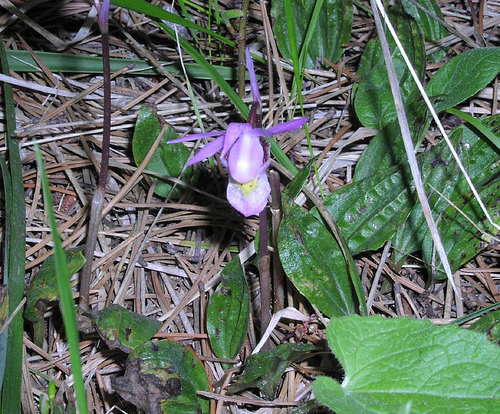
Calypso bulbosa, Calypso orchid, Cypress Hills Interprovincial Park,
Canada
(*photo
credit)
July 24, 2007 Corn: The Corny Biofuel
Our special issues on "Biofuels" treats the problems
associated with a wasteful practice (fueling gas guzzlers) that is
meant to be a "green" 21st century practice. Some of the biofuels
are in the research stage but fermentation of corn has a long
history and needs little further research. The resulting ethanol
approach takes much fuel to do the job (and some suspect that it is
even a negative energy producer if all factors are counted). Just
as in fossil fuels, carbon dioxide emissions occur here as well as
some toxic pollutants. But besides all of the many discussed
disadvantages as a biofuel, there is a most important corn-related
problem: converting corn to biofuel diverts it from use in some
animal feed and from food. This drives up the price of corn
products not only for poor Mexicans who rely so heavily on
tortillas as a basic staple of diet, but also in almost any
American food product containing corn oil or syrup.
The very "giddy senators" (Wall Street Journal's words) who
voted for an energy bill that required the nation to use 7.5
billion gallons of ethanol annually have suddenly been beset by an
angry public, which includes a host of powerful lobby organizations
asking whether these dimwits knew what they were doing -- and they
certainly didn't any more than their pale-"green" backers. Those
at the trough of federal subsidies could well afford to seek
biofuels provided they take the narrow view of keeping luxury cars
moving and allow the rest of the hungry world to be damned. So we
find intense lobbying efforts by the National Turkey Federation,
National Chicken Council, Grocery Manufacturers Association and
such biggies as Tyson's and Coca Cola (we differ on other points)
who see their profits dwindle due to soaring prices of corn feed
and corn syrup. This is called a case study in how one lobby group
has overplayed its hand. Currently, the susceptible congress
members are back-pedaling from subsidizing the corn distilling
industry to the tune of billions of dollars. "Corny" is the buzz
word and an entire nation is slowly awakening to being taken for a
heap of money. There are cheaper ways to be green.
Once the clamor picks up, the corn profiteers are actually
found to be in a minority; this is good news for those of us who
cautioned to go slow with biofuels and make some distinctions
between those that are the result of recycling of waste and those
made by diverting food or other virgin materials. The biofuel tide
has changed, even since January's State of the Union message when
a President, who sought to improve his environmental track record,
called for biofuels to replace Middle East oil. And President
Bush's mention of switch grass in 2006 as a possible biofuel is far
from actual application. Nevertheless, European allies want to
sustain their only slightly less wasteful fuel practices by using
palm oil. This extra demand requires the destruction of rain
forests for palm plantations.
Again, we must practice resource conservation and emphasize
renewable energy such as solar, wind energy and geothermal.

Mountain rhododendron, Laurel Co., Kentucky
(*photo
credit)
July 25, 2007 The Mountain Rhododendron
The rhododendron (Ericaceae) is the flower of choice for many
in Appalachia, and festivals celebrate this large floral family
with many species of exquisite colors (e.g. Roan Mountain Festival
in Tennessee). And the exquisite rhododendron is not limited to
here in Appalachia but is found in any moist generally alpine
terrain in the Northern Hemisphere and even beyond. For instance,
the Himalayan region from Kashmir east is blessed with this flower;
its greatest diversity is found in southern China, Nepal (national
flower is Rhododendron arboreum) and Sikkim (national flower
is
Rhododendron niveum). Not to be outdone, Appalachia's
rhododendron
is just as prized and is West Virginia's state flower and even
adorns the flag of the "Mountain State." With all due respect, the
world loves this flower!
Due to differences in local climatic conditions and
topography, the rhododendron blooming season is just as broad-
ranging, even within a given region. Thus we are blessed with
these prolific native flowers through parts of spring and well into
summer. I recall that the southern terminal miles of the Blue
Ridge Parkway in Tennessee and North Carolina are flanked by
hillsides of the "rose trees" of the hills. Furthermore, many
gardens of this region and other parts of our country contain
azeleas (a hybrid cousin), the profuse blooms of which herald the
floral season in early spring. And an added positive
characteristic is that these are most often evergreen bushes giving
color during the non-blooming part of the year. Our azelea blooms
budded early this year due to a warm March and then were killed
before full bloom during an unusually cold mid-April period.
While none of us can say anything against the blazing beauty
of the rhododendron, Appalachians have the expression, "They are
beautiful to see, but hell to walk through." The picture proves
the first; any cross-country hiker in the mountains can testify to
the second. The only other negative is that they do not give us an
additional edible landscape species. Even the honey from the
blooms is known to make people sick and the Greek Xenophon over two
millennia ago noted the hallucinogenic effects of certain eastern
Mediterranean species of the rhododendron.
If you are still interested in further information, you may
contact the American Rhododendron Society at Niagara Falls, New
York or email to <lauragrant@arsoffice.org>, or call (416) 424-
1942. This organization's activities include public education,
flower shows, seed exchanges, scientific studies, communication
through publications and the Internet, and local and national
meetings.
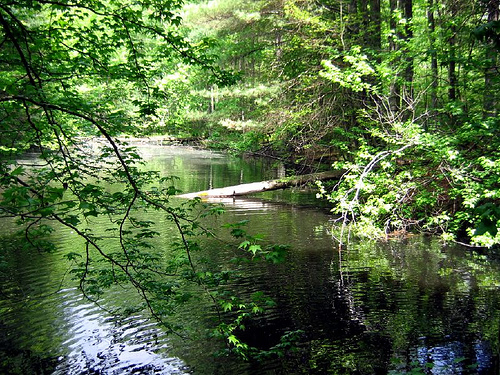
Hidden pond, Daniel Boone National Forest. Powell Co.,
Kentucky
(*photo
credit)
July 26, 2007 The Value of Ponds
Someone may ask, "When is a lake, a lake, and a pond, a pond?"
Where I grew up we had four water body designations: a puddle, a
pool, a pond, and a lake -- and how much of a designation you would
bestow upon each body depended on exactly how wealthy you were. On
our farm we had pools where spring water was collected in a walled
enclosure with limited access to livestock; and we had a pond
which was really a small lake (see July 8, 2004). In the middle of
summer, when the landscape would become somewhat brown from
drought, these improved pools and excavated ponds were of immense
value as one might expect, for all life including livestock demands
water. And beside the agriculturalists' designations, the
naturalists have their own world of nomenclatures. But some, as
our photograph indicates, are natural ponds and these also have
value in slaking the thirst of wildlife, and as a welcome habitat
for a host of little critters and aquatic life. In all parts of
the world, the pond is a place of congregation, a watering hole,
and often a remnant of former broader wetlands.
The well placed and protected pond, like larger lakes can
serve on a small level as a recreational place (though with some
liability problems related to intruders), and replenishment for the
water table. Like lakes, ponds can also increase the land's
economic value and add to the harmony of the landscape. They also
require proper siting and planning, and, since the water comes from
the surrounding countryside, the watershed control and protection
from commercial chemicals is important as in larger lakes -- though
the water is derived from a smaller watershed. Ponds can be fish
habitats though the variety of fish is limited and the quantity may
need to be small, depending on the degree of water recharging that
is occurring. Quite often, artificial feeding of the fish may be
necessary in an aquicultural project.
One nice thing about ponds is that they are more manageable
than lakes provided the proper care has been taken from the
beginning. If a nutrient-rich water source is permitted, the
summertime pond gets a scum on the surface that makes it
unattractive for almost all the beneficial purposes just mentioned.
However, care can keep this from happening (anti-scum agents are
commercially available), and some forms of fish help reduce the
blooming scum from occurring provided they have sufficient oxygen
to survive. Livestock, with access to the pond edges for drinking
(rather than the pond being fenced off and water piped into
drinking troughs as recommended), are often the cause of the super-
nutrient condition of the ponds.
Just as in a lake situation, a variety of plants can enhance
the beauty of the pond edge and also help supply natural food for
any fish present. Wetland plants are well suited for the shore
line, and trees such as willow and mulberry can add beauty as well.
Listings of additional plants are available in your County
extension office. Amid it all, ponds can be properly managed year-
round -- but July is a challenging month.
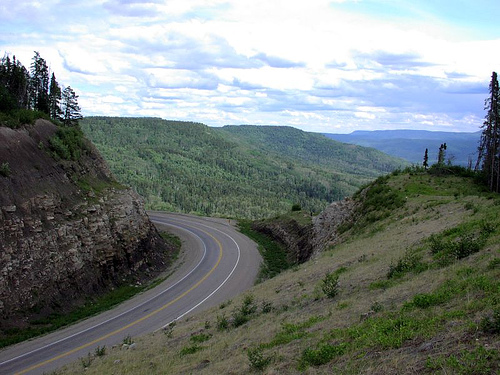
Road scene, overlooking vast terrain after leaving Fort Nelson, BC
(*photo
credit)
July 27, 2007 Focus and
Concentration
In the haze of July's seeming endless heat, we travel about
and sometimes the distance appears so far away we lose our sense of
focus. Sunlight and summer heat combine to blind us or at least to
make us lose our focus. I came upon my simple undated verse --
which I think I wrote, but even my recall of words is fading.
Simply put, no one else would have done such a thing -- so it must
be mine. It does give a sense of July that is different from other
months at least here in Kentucky. Mid summer heat makes it harder
to focus attention and so we fall back on past resolutions and
orientation, trusting that our bearing is right and the goal is up
ahead even though beyond our vision. When I look up and notice the
moth again and again bouncing off the light bulb, it reminds me of
where my concentration ought to be.
FOCUS
I try to pray, Oh Lord, to you
yet all becomes a host of things to do.
As I surmise the overwhelming milieu
with moments too few, too few.
Again, I pray the liturgy of the day,
again as before, the thoughts betray
feet of clay verging closer to harm's way.
Please deliver me from this fray.
Battle plans, ego stands,
helping hands, threatened lands,
endless fights, warring clans,
fleeting time, countless spans.
Lord make me a moth seeking Light,
centered on a distant rare delight;
In this brief darkness keep it bright,
Focused on a way-off sight.
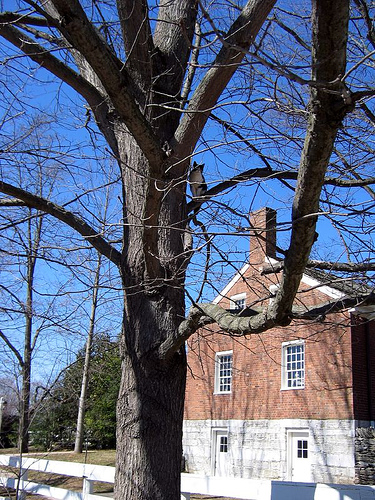
Peering up at a cat in tree. Shakertown of Pleasant Hill,
Kentucky
(*photo
credit)